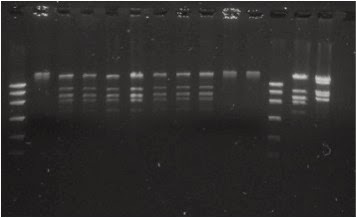The molecule for this month is GFP, the green fluorescent protein from the jellyfish Aequorea victoria. This protein has generated considerable interest in experimental biology, and its applications in cell biology in particular warrant its inclusion as a molecule of the month. It is a naturally occurring protein with a function that remains controversial in its normal host organism. However, by combining the power of fluorescence detection with gene fusion and cell transfection technologies, the GFP has made the experimental investigation of cellular processes much more illuminating!
So how does it work? First we need to understand fluorescence. If you look at the definitions of fluorescence, they require you to understand luminescence. So first, luminescence is the emission of light without the input of heat. This is in contrast to incandescence, which is the emission of light that arises when you heat a metal object, such as a light filament. The energy input in the case of fluorescence is electromagnetic radiation: the absorption of a photon of light leads to excitation which is followed soon after (usually in a few thousandths of a second or less) by the emission (or release) of light at a longer wavelength (remember the longer the wavelength, the lower the energy). For completeness there are two other phenomena that are similar. Phosphorescence is very similar to fluorescence, but instead of an almost instantaneous emission of light, there is a delayed release, which is a consequence of a different pathway of excitation and relaxation of electrons in the molecule. Chemiluminescence is the emission of light during a chemical reaction (this is important in some forms of DNA analysis and in the detection of antigens using some antibodies).
The beauty of GFP, is that the physico-chemical origin of its fluorescence does not require the addition of a co-factor: it is entirely embodied in the primary structure of the molecule. Hence, by introducing the gene encoding GFP into any cell, there is no metabolic barrier to eliciting a fluorescent signal. There are of course other reasons why a recombinant GFP might not express its fluorescence, including failure to express (as a gene, or as a translation product), degradation in the host cell by proteases. It is also possible that the expression of GFP is not coordinated in time or space with the process being investigated. But, most of these hurdles can be overcome by systematic investigation. Professor Roger Tsien (who shared the Nobel Prize for his work on GFP), published a subtle mutational variant of GFP in which a serine residue was changed to a threonine. This led to a significant improvement of the GFP in respect of its spectral properties: this mutant forms the basis of most applications of GFP in molecular cell biology. You should think carefully about this mutation by looking at the structures and considering the fact that in contrast to GFP, these two residues are "viewed" as essentially the same by many protein kinases.
 Perhaps the most powerful application of GFP is the the revolution GFP has brought about in biological microscopy. Pre-GFP, it was extremely difficult to identify molecules under the light microscope. The methodology often required combining antibody recognition, with the use of small fluorophores such as fluorescein. However, this methodology is specialized, relatively expensive and time consuming. By coupling GFP to a target molecule (using relatively simple cloning technologies), it is now routine to identify a protein molecule and observe its behaviour in the cell. This can be useful in the study of drug targets, fundamental understanding of the role of a protein in time and space and in identifying the way it interacts with other proteins. It is in fact possible to "tune" the fluorescent properties of GFP making it yellow or red! The advantage of this, lies in the ability to measure protein proximity, by the fluorescence changes that can often be observed when two fluorophores come together. This phenomenon is called fluorescence resonance energy transfer, or FRET.
Perhaps the most powerful application of GFP is the the revolution GFP has brought about in biological microscopy. Pre-GFP, it was extremely difficult to identify molecules under the light microscope. The methodology often required combining antibody recognition, with the use of small fluorophores such as fluorescein. However, this methodology is specialized, relatively expensive and time consuming. By coupling GFP to a target molecule (using relatively simple cloning technologies), it is now routine to identify a protein molecule and observe its behaviour in the cell. This can be useful in the study of drug targets, fundamental understanding of the role of a protein in time and space and in identifying the way it interacts with other proteins. It is in fact possible to "tune" the fluorescent properties of GFP making it yellow or red! The advantage of this, lies in the ability to measure protein proximity, by the fluorescence changes that can often be observed when two fluorophores come together. This phenomenon is called fluorescence resonance energy transfer, or FRET. |
| Scientists at MIT, use GFP to monitor cell death in their search for new drugs |








































